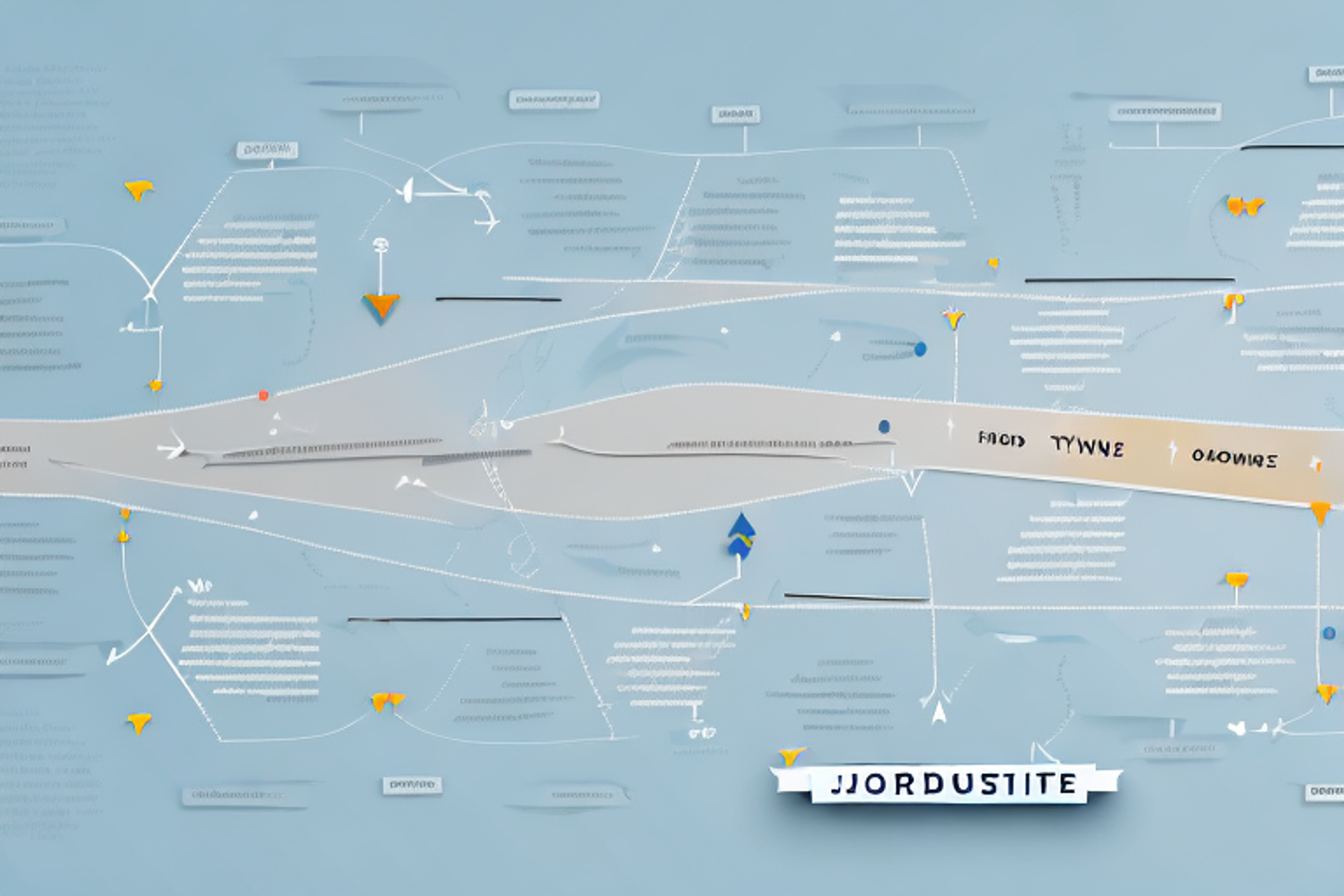Mastering the Product Roadmap: Templates, Examples, and Tips
Learn how to create an effective product roadmap with our comprehensive guide.
Posted June 13, 2025

Join a free event
Learn from top coaches and industry experts in live, interactive sessions you can join for free.
Table of Contents
Creating a product roadmap is an essential part of any business strategy. It helps you to communicate your vision, priorities, and goals to stakeholders, while also providing a clear framework for your development team to work within. In this article, we'll cover everything you need to know to master the product roadmap, including templates, examples, and tips that will help you to create a roadmap that is tailored to your business's needs and priorities.
Why a Product Roadmap is Essential for Your Business Success
A product roadmap is a strategic document that outlines your company's vision for the future of your product. It serves as a visual representation of the journey you plan to take to achieve your goals. But why is a product roadmap so essential to your business's success?
Firstly, it communicates your product vision and strategy to your stakeholders, including investors, employees, and customers. This helps them to understand the direction you're heading in, and enables them to provide feedback and support.
Secondly, a product roadmap provides a clear framework for your development team to work within. By breaking down your goals and milestones into smaller, achievable tasks, you can ensure that your team is on track to deliver your project successfully.
Finally, a product roadmap helps you to prioritize your development efforts and make informed decisions about what to work on next. By clearly defining your goals and objectives, you can ensure that every feature and enhancement you add to your product aligns with your business strategy.
The Different Types of Product Roadmaps and How to Choose the Right One
There are several different types of product roadmaps, each of which serves a different purpose. The most common types of product roadmaps include:
- Strategic Roadmaps
- Release Roadmaps
- Feature Roadmaps
- Portfolio Roadmaps
To choose the right type of product roadmap for your business, you need to consider your objectives, audience, and development process. For example, if you're focused on a long-term strategy, a strategic roadmap may be the best option. If you're looking to communicate your progress with customers, a release roadmap may be a good fit. Consider your audience and what they need to know, and choose the roadmap that provides the most value to them.
Creating a Product Roadmap: A Step-by-Step Guide
Now that you understand why a product roadmap is essential and how to choose the right type, it's time to learn how to create one. Here is a step-by-step guide to help you create a product roadmap that is tailored to your business:
- Define Your Vision and Goals: The first step is to define your vision and goals for your product. What problem are you trying to solve, and how do you want your product to help customers?
- Gather Feedback: Once you've defined your vision and goals, you need to gather feedback from stakeholders. This includes customers, investors, and employees. Use this feedback to refine your roadmap and ensure that it aligns with your business strategy.
- Create a High-Level Roadmap: Based on your goals and feedback, create a high-level roadmap that outlines your product's key milestones, including major releases, feature updates, and enhancements.
- Break Down Your Goals: Once you have a high-level roadmap, it's time to break down your goals and milestones into smaller, achievable tasks. This will help you to prioritize your development efforts and ensure that you're on track to achieve your objectives.
- Assign Tasks and Set Deadlines: Assign tasks to your development team and set deadlines for completion. This will help you to keep track of progress and ensure that everyone is working towards the same goals.
- Communicate Your Roadmap: Finally, communicate your roadmap to stakeholders. This includes your development team, investors, and customers. Use visual aids such as charts and diagrams to make it easier to understand and follow.
Key Components of a Successful Product Roadmap
A successful product roadmap should include several key components:
- Milestones and Goals
- Feature Prioritization
- Timeline
- Communication Plan
By including these components in your roadmap, you can ensure that it is comprehensive and provides value to your stakeholders.
How to Align Your Product Roadmap with Business Goals and Objectives
One of the biggest challenges in creating a product roadmap is aligning it with your business goals and objectives. To ensure that your roadmap is aligned, you need to:
- Understand Your Business Objectives: Start by understanding your business objectives and how your product fits into them. This will help you to determine what features and enhancements you need to prioritize.
- Track Metrics: Use metrics to track your progress towards your business objectives. This will help you to ensure that your product roadmap is aligned with your goals and that you're making progress towards them.
- Communicate with Stakeholders: Communicate your roadmap and progress to stakeholders regularly. This helps to keep everyone aligned and ensures that everyone is working towards the same objectives.
Tips for Prioritizing Features on Your Product Roadmap
When prioritizing features on your product roadmap, it's essential to consider several factors, including:
- User Needs: Prioritize features that meet your users' most pressing needs.
- Business Goals: Ensure that every feature aligns with your business strategy and objectives.
- Technical Feasibility: Prioritize features that are achievable with your existing technology and infrastructure.
- Impact: Consider how impactful each feature will be and prioritize those with the highest potential impact.
By considering these factors when prioritizing features, you can ensure that your product roadmap is focused on delivering value to your users and achieving your business goals.
Best Practices for Communicating Your Product Roadmap to Stakeholders
When communicating your product roadmap to stakeholders, it's essential to follow best practices such as:
- Use Visual Aids: Use charts, diagrams, and other visual aids to make your roadmap easier to understand.
- Be Clear and Concise: Communicate your goals and objectives clearly and avoid being overly technical or complex.
- Invite Feedback: Encourage stakeholders to provide feedback and ask questions to ensure that everyone is on the same page.
- Update Regularly: Update your stakeholders regularly on your progress and any changes to your roadmap.
Following these best practices will help you to ensure that your stakeholders are engaged and informed about your product roadmap.
Incorporating User Feedback into Your Product Roadmap Strategy
User feedback is essential for creating a successful product roadmap. To incorporate user feedback into your strategy, you need to:
- Collect Feedback: Collect feedback from your users through surveys, interviews, and other methods.
- Analyze Feedback: Analyze the feedback you receive and look for patterns and trends that can inform your product strategy.
- Prioritize Feedback: Prioritize feedback based on its impact on your users and business goals.
- Incorporate Feedback: Incorporate feedback into your product roadmap by adding features and enhancements that meet your users' needs.
By incorporating user feedback into your product roadmap, you can ensure that you're providing value to your users and meeting their needs.
How to Use Metrics to Measure the Success of Your Product Roadmap
Metrics are essential for measuring the success of your product roadmap. To use metrics effectively, you need to:
- Define Success Metrics: Start by defining the metrics that you'll use to measure success, such as customer satisfaction, revenue growth, or feature adoption.
- Track Metrics: Track your metrics regularly to ensure that you're making progress towards your goals.
- Analyze Metrics: Analyze your metrics to identify trends and areas for improvement.
- Iterate Your Roadmap: Use your metrics to inform changes and updates to your product roadmap, ensuring that you're constantly improving and delivering value to your users.
By using metrics to measure the success of your product roadmap, you can ensure that you're achieving your business objectives and continually improving your product.
Common Mistakes to Avoid When Creating a Product Roadmap
When creating a product roadmap, it's easy to make mistakes that can derail your progress. Some common mistakes to avoid include:
- Not Aligning with Business Objectives: Ensure that your roadmap aligns with your business objectives and strategy.
- Overcommitting: Be realistic with your timeline and goals to avoid overcommitting and underdelivering.
- Ignoring Feedback: Listen to feedback from stakeholders and incorporate it into your roadmap to ensure that you're meeting their needs.
- Not Prioritizing: Prioritize features and enhancements to ensure that you're focused on delivering value to your users and achieving your business goals.
By avoiding these common mistakes, you can ensure that your product roadmap is effective and delivers the results you need.
Examples of Successful Product Roadmaps from Top Companies
Looking at successful product roadmaps from top companies can provide inspiration and ideas for your own roadmap. Here are a few examples:
- Apple: Apple's product roadmap is focused on delivering innovative and high-quality products, with a clear focus on customer needs and feedback.
- Google: Google's product roadmap is centered around its mission to organize the world's information and make it universally accessible and useful. It focuses on delivering value to users through innovative products and services.
- Amazon: Amazon's product roadmap is focused on delivering a seamless and convenient shopping experience for customers, with a focus on features and enhancements that drive customer loyalty and engagement.
By studying successful product roadmaps from top companies, you can learn from their strategies and apply their best practices to your own roadmap.
The Role of Agile Methodology in Developing a Winning Product Roadmap
Agile methodology is a popular approach to software development that prioritizes flexibility and collaboration. When developing a product roadmap, using agile methodology can help you to:
- Be More Responsive: Agile methodology allows you to respond quickly to changes in the market or user needs.
- Collaborate Effectively: Agile methodology empowers your team to collaborate effectively and ensure that everyone is aligned and working towards the same goals.
- Deliver Frequently: Agile methodology allows you to deliver features and enhancements more frequently, ensuring that you're constantly improving and meeting user needs.
By incorporating agile methodology into your product roadmap strategy, you can ensure that you're staying responsive, nimble, and focused on delivering value to your users.
How to Adapt Your Product Roadmap in Response to Market Changes
Market changes can derail even the most well-planned product roadmaps. To adapt your roadmap in response to market changes, you need to:
- Stay Informed: Keep up-to-date with market trends, user needs, and new technologies that may impact your product.
- Be Flexible: Be prepared to adjust your roadmap in response to market changes, even if it means changing your priorities or timeline.
- Communicate Changes: Communicate any changes to your product roadmap to stakeholders to ensure that everyone is aligned and informed.
By staying informed, flexible, and communicative, you can adapt your product roadmap to meet the ever-changing needs of your users and market.
Future-Proofing Your Product Roadmap: Trends and Predictions for the Industry
To future-proof your product roadmap, it's essential to stay ahead of industry trends and predictions. Some of the biggest trends and predictions for the industry include:
- Artificial Intelligence: AI is becoming increasingly important in product development, with applications ranging from chatbots to predictive analytics.
- Internet of Things: The IoT is creating new opportunities for product innovation, with smart home devices and other IoT-enabled products taking center stage.
- Virtual and Augmented Reality: VR and AR are expanding beyond gaming and entertainment into fields such as education, healthcare, and industrial design.
By incorporating these trends and predictions into your product roadmap, you can ensure that you're future-proofing your product and staying ahead of the curve.
Conclusion
In conclusion, mastering the product roadmap is essential for any business looking to achieve success through product development. By using the templates, examples, and tips provided in this article, you can create a product roadmap that aligns with your business goals and delivers value to your users.
Remember to prioritize features, stay responsive to market changes, incorporate user feedback, and measure your success with metrics. By following these best practices and taking a strategic approach to product development, you can ensure that your roadmap is effective and delivers the results you need.
Browse hundreds of expert coaches
Leland coaches have helped thousands of people achieve their goals. A dedicated mentor can make all the difference.



























